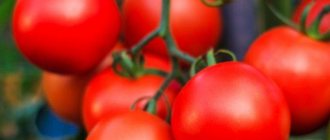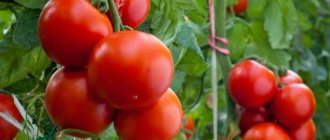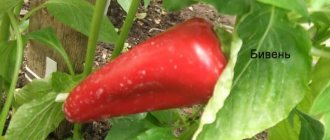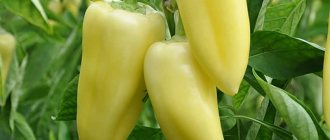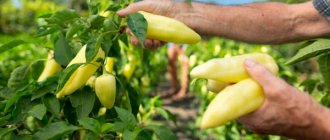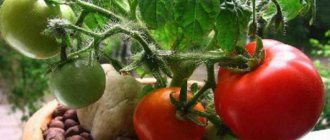Cherry tomatoes are very popular. Small tomatoes collected in bunches look attractive in salads and canned whole. “Cherry” tomatoes are also appreciated by adherents of a healthy diet, because the concentration of nutrients in them is higher than in large fruits.
Cherries are often difficult to care for and do not take root well in our climatic conditions. But this does not apply to the Barberry f1 tomato. It is easy to grow; with proper agricultural technology, the hybrid gives a high yield, has excellent taste and shelf life. Next, we will look at all the nuances of cultivating and caring for these tomatoes.
General description of the hybrid
The Barberry tomato is a hybrid . It was developed by crossing two varieties. The seeds of its harvest are not suitable for planting, since the plants grown from them in most cases do not retain hybrid characteristics, acquiring parental ones.
The hybrid is produced by many domestic seed producers.
Attention! Reviews from gardeners indicate that some manufacturers produce other varieties of tomatoes called Barberry. Their fruits are not red, but pink, and the seeds are suitable for replanting.
Distinctive features
The main distinguishing feature of Barberry is the miniature size of its fruits.
Tomatoes are oval in shape and resemble enlarged barberries (see photo). This is a carpal hybrid . Up to 100 fruits can grow on one brush, which gives the bush a special decorative appearance.
The tomatoes taste sweet , with a slight sourness. They have a brighter and more pronounced taste than other varieties of tomatoes.
The shape of the bushes is also interesting : they are not very spreading and grow mainly in height.
Main characteristics
Despite the ease of cultivation, the hybrid produces high yields and has excellent taste.
Characteristics of tomato Barberry:
| Parameter | Indicators |
| Bush type | Indeterminate hybrid. Grows up to 2 m. The stems are powerful. The bushes have an average amount of greenery. The leaves are ordinary, medium in size and light green in color. It feels somewhat sticky to the touch. The fruits are formed in clusters. From 70 to 100 berries are formed on one brush. On average, there are 5-6 brushes on a bush. The first flower raceme appears between the 7th and 14th leaves |
| Growing method | Possible to grow in greenhouses and open ground. Gardeners who have tried to grow this tomato in both ways say that in a greenhouse the harvest is of better quality |
| Productivity | High for cherry tomatoes. From 1 sq. m of planting of this hybrid produces 7-10 kg of fruits |
| Fruit | Miniature. The weight of one fruit varies between 25-40 g. The tomatoes are red on the outside (sometimes there are pink tomatoes with the same name). The inside of the fruit is red, without light and green spots at the base. Medium fleshy, non-watery. On average, one tomato has two chambers with a small number of seeds. The fruit tastes sweet, with a slight sourness. Sugar content for tomatoes is high – 8% |
| Transportability | High. Tomatoes have thick skin, making them suitable for long-distance transportation. They are stored for more than a month. Keeping quality increases when storing fruits on a cluster |
| Ripening time | Early ripening variety. The first fruits ripen three months after emergence. Tomatoes ripen evenly on the bunch. Fruiting continues until the end of August |
| Disease resistance | Is immune to viral diseases. Gardeners note that Barberry rarely suffers from fungal diseases. |
Characteristics of the variety
Barberry F1 tomatoes are early ripening varieties. From the moment of planting until the appearance of the first fruits, no more than 95 days will pass. The height of an adult plant reaches two meters. The fruits grow in large clusters, like grapes. You can count up to 70 tomatoes on one powerful brush. The first tomato cluster is formed above the fifth or sixth leaf. The leaves are of normal shape and sticky.
On one bush, as a rule, from three to five clusters are formed, densely overgrown with tomatoes. Tomatoes have high yields - this is an important characteristic.
Sowing seeds
The Barberry tomato is grown in our country exclusively by seedlings . Seeds are sown 55-60 days before planting seedlings in the ground: in central Russia - in the second half of March, in the south of our country - in early February, in the north - in the first ten days of April. For greenhouse cultivation, earlier sowing is possible.
Processing of planting material
Before buying seeds, you need to check their expiration date . Expired planting material has low germination rates.
To select seeds that will germinate , they need to be soaked in salted water (take 1 teaspoon of salt per glass of liquid) for half an hour. The seeds that sink to the bottom are suitable for planting.
Attention! Some manufacturers treat planting material. This information is indicated on the packaging. Disinfected seeds are distinguished by orange or light green color.
If the seeds are not treated in the factory , they do it themselves. Several methods are used for this:
- The seeds are soaked in a solution of potassium permanganate: take 2 g of potassium permanganate per 200 ml of liquid (the solution should turn out light pink).
- In “Fitosporin”: take 0.5 teaspoons of powder or 2 drops of liquid “Fitosporin” per glass of water. The soaking time should be according to the instructions.
- In a soda solution: take 1 teaspoon of soda per glass of water. The seeds are immersed in the composition for 12 hours.
After disinfection, the planting material is treated with a growth stimulator. Epin is often used for this. A solution of honey (1 teaspoon of honey per glass of water) also shows good results.
It is important to use the growth stimulator correctly : saturate a piece of cloth with it, wrap the seeds in it, put it on a saucer, cover with film and place in a warm place. On average, soaking takes 12 hours.
About other varieties of tomatoes:
A find for gourmets - tomato “Moscow delicacy”
Disease-resistant and unpretentious tomato “Pink Stella”
Unpretentious tomato "Marusya" with excellent taste
Preparing soil and containers
The soil for tomatoes should be light but nutritious . Suitable soil is available at garden supply stores. Prepare soil mixtures for tomatoes yourself.
The basis of the soil for tomatoes is peat, turf and humus (one portion each). To make the soil lighter, add sand, sawdust or crushed coconut substrate (half a portion). To increase nutritional value, ash and “Superphosphate” are added to the soil mixture.
Containers for sowing seeds are large and shallow. Stores sell special boxes and trays. Disposable deep plates, instant noodle packages, cake lids, etc. are also used for these purposes.
Plants are planted in deep containers with a volume of at least 300 g. For these purposes, special pots, disposable cups or cut-off 1.5-2 liter bottles are used.
All containers are disinfected by soaking for half an hour in a dark pink solution of potassium permanganate. Some materials are doused with boiling water. To disinfect, the soil mixture is calcined in an oven at a temperature of 100°C or watered with a solution of potassium permanganate. Another option is to put the soil in a colander and pour boiling water over it.
Sowing
The soil is placed in the prepared container so that 3 cm is left free to the edges. The seeds are laid in rows at a distance of 3 cm from each other. The planting material is sprinkled with a centimeter layer of soil on top.
The soil is moistened with a spray bottle with warm water and covered with film. After this, it is removed to a warm place. The warmer the seeds are, the faster they will germinate.
Advice. If mold appears on the soil, it means it is waterlogged. To cope with the problem, the affected layer is removed and the missing amount of soil is added. After this, the soil is watered with a weak solution of potassium permanganate and left to dry without film.
Seedling care
To grow healthy plants, they need to be properly cared for.
Basic nuances of growing tomato seedlings:
- When the first shoots appear, the plants will need 16 hours of daylight. Usually in spring there is not enough natural light, so gardeners use special lamps.
- Seeds and newly germinated seedlings need extreme humidity. It is to ensure this that containers with soil are covered with film. When the first shoots appear, the film is not removed, but is opened slightly every day for several hours. A week later, the improvised greenhouse is dismantled.
- After two true leaves appear, the plants are planted in separate containers. There are different opinions about whether it is necessary to pinch the central root during the picking process. Some gardeners believe that this will only slow down the growth of seedlings, while others believe that thanks to this procedure the plants will become more hardy.
- During cultivation in a common box, the plants are watered with a pipette. A week after picking, the soil is moistened with a watering can. This is done so that water does not get on the ground part of the plants.
- Feed the seedlings three times. The first - two weeks after picking, the second - another two weeks, the last - five days before planting the plants in open ground.
- 14 days before transplanting to a permanent location, tomatoes begin to harden. To do this, the seedlings are taken out into the fresh air every day, gradually increasing the time.
'Idil cocktail red'
In my opinion, idil is close to ideal.
And this is truly an impeccable cocktail variety. Tomato 'Idil cocktail red' Indeterminate, 1.5-2 m high. Mid-season (100-110 days). The fruits are bright red, round, sour, weighing 20-30 g, collected in 20 pieces. in the brush.
'Kish-Mish red F1' and 'Kish-Mish yellow F1'
Excellent cherry hybrids that can be prepared dried for gourmet dishes.
Tomato 'Kish-Mish red F1', photo from sadovodu.com. Tomato 'Kish-Mish yellow F1', photo from flos.ru.
Indeterminate, 1.6-2 m high. Medium early. The fruits are bright red and bright yellow, round, sweet, weighing up to 20 g, collected in 20-50 pieces. in the brush.
How to grow tomatoes
Tomatoes are planted in open ground when the soil warms up . In the southern regions this is done at the end of April or beginning of May, and in the middle zone - in the second half of March. In the northern regions, Barberry tomatoes are planted only in greenhouses. Gardeners note better yields in protected soil and in warmer cities.
The growing area must be sufficiently lit. Therefore, to place tomato beds and greenhouses, choose the sunniest place in the garden.
Planting seedlings in a permanent place
The beds for tomatoes have been prepared since autumn .
They are dug up and cleared of weeds. Then dry lime, cow dung and humus are spread over the selected area. In the spring, the beds are dug up again and cleared of emerging roots. After this, holes are dug in rows in a checkerboard pattern . A distance of 60 cm is left between the rows, and 50 cm between the holes. Add 1 tbsp to each hole. l. ash. It is useful to pour long-acting granular complex fertilizers into the seedling holes.
Five days before planting in open ground, the seedlings are watered and fed . Immediately before planting, tomatoes are removed from the pots along with the soil. It is extremely important not to damage the roots. The tomatoes are placed in the holes, deepened by removing the two bottom leaves, and the soil is moistened. Next time the tomatoes are watered after two weeks.
Care
Hybrid Barberry is indeterminate, so it needs a garter so that the plant does not break under the weight of the fruit and does not lie on the ground. For gartering, use a high wooden support or trellis. When choosing a support for a tomato, you need to take into account that the bushes reach 2 m in height. The plant is tied up as it grows.
Barberry bushes need shaping . Usually two or three stems are left. In both cases, high yields are observed. This hybrid produces many stepsons. They need to be removed regularly. This procedure is carried out in the morning or evening, not on cloudy days.
Growing tomatoes
Water the tomatoes as the soil dries in the morning or evening . Watering should be plentiful and infrequent. On the day of planting, the soil is not moistened. Use only settled water. It is important that during watering the liquid does not fall on the ground part of the bush.
During the season, tomatoes are fed 3-4 times, alternating organic and mineral fertilizers . Complex mineral fertilizers are sold in stores, while organic fertilizers are often prepared independently.
To prepare organic fertilizer, you need to pour 1/10 of the manure, 1/3 of the plants into a bucket, fill the rest of the space with warm water and place in a warm place for fermentation. When the mixture ferments, it is diluted with the same amount of water.
Twice a season, plants are sprayed with products containing boron - this accelerates the formation of ovaries.
Features of cultivation
Sometimes there are reviews that speak of an unexpressed taste or insufficient quantity of Barberry fruits. This happens if the gardener does not follow some important rules for caring for a hybrid :
- Uniform ripening of tomatoes in the bunch is ensured artificially. To do this, after the fruits appear, remove all the leaves under the cluster.
- Tomatoes are self-pollinating plants. Despite this, to increase the yield, the bushes need to be shaken regularly.
- All incorrectly formed inflorescences must be removed. This will help high-quality fruits ripen faster.
- The more sun the plant receives, the sweeter the fruits will be.
Protection from diseases and pests
Barberry is resistant to tomato viral diseases . This makes it much easier to care for.
to fungal diseases is not so pronounced. Therefore, to prevent infection of tomatoes, it is important to follow the rules of prevention. The soil, containers and garden tools that interact with tomatoes are disinfected with a solution of potassium permanganate or copper sulfate. Seeds also need to be treated before planting. It is important to follow the watering rules. Dry and waterlogged soil are ideal conditions for the development of fungal infections.
Incorrect stepsoning also causes illness . For prevention, the bushes are sprayed with “Fitosporin”, copper sulfate or a solution of potassium permanganate. During the season, 2-3 such sprayings are done.
To protect plants from pests , they are sprayed with a soap solution or infusion of celandine. Large insects are collected by hand.
Growing and care
In order not to attract pests to the beds with tomatoes and to prevent diseases from developing, tomatoes are not planted after or next to nightshade crops. Aromatic herbs, seasonings and flowers (calendula and marigolds) should be planted between the rows.
Also, sowing green manure before planting tomatoes will be a good disease prevention measure. It is advisable to plant herbs such as white mustard, phacelia or alfalfa in autumn and spring; the roots will improve the soil and drive away unwanted guests, and the greens can be used as mulch.
Tall, and especially such productive tomatoes need strong supports for garter. At the same time, it is necessary to attach not only trunks, but also brushes to various structures. Hilling is not a mandatory procedure, but desirable. But you need to loosen the soil after each watering. The foliage is removed from the bottom of the bush.
Both mineral complexes and organic matter can be used as fertilizers. Tomatoes will not produce well in poor soil. Watering is usually combined with fertilizing. The first time the crop is fertilized 2 weeks after planting in a permanent place, then the sessions are repeated every 15–20 days.
Not every cherry tomato can boast such an enviable number of positive qualities. All 3 Barberry hybrids are able to withstand adverse weather conditions and not lose their fertility. All they need is to follow the basic rules of care.
Features of agricultural technology in greenhouses and open ground
tomato is grown in greenhouses and open ground . There are some differences in cultivating tomatoes using these methods.
to maintain optimal air humidity in the greenhouse It should not exceed 65%. It is not difficult to achieve the desired indicators. To do this, ventilate the greenhouse daily by opening the windows.
In open ground, it is important to protect plants from night frosts. To do this, at first they are covered with film.
To protect plant roots from cold, pests and diseases, open ground beds are mulched with burlap, hay or straw.
Ideal variety for greenhouses
Barberry variety tomatoes are ideal for growing in greenhouse conditions. Due to the fact that the bushes are not spreading, but grow vertically upward, they do not take up much space. In this way, the entire space can be distributed efficiently.
You should not reduce the distance between the bushes, this will lead to a decrease in yield. It is better to leave no more than 0.6 meters between rows. The greenhouse must be located in a well-lit place. All tomato varieties are light-loving. Due to lack of light, they ripen poorly and become tasteless.
In order for tomatoes to be well pollinated in greenhouse conditions, it is necessary to maintain air humidity within 65%. Artificial pollination can be used.
Harvesting and application
The first Barberry harvest is harvested in July . Fruiting continues until the end of August. The fruits are picked from the bush when all the tomatoes on the bunch are ripe. To do this, cut off the whole brush. Tomatoes are stored directly on it. In this form they will lie for more than a month.
Tomatoes are used for canning, drying and fresh consumption. They are even frozen whole.
Feeding tomatoes
Even if the soil in the greenhouse was sufficiently fertilized and properly prepared before planting, the plant will still have to be fed from time to time - this will increase the yield. The main thing is not to use chemical fertilizers, but you can make natural ones yourself. To do this you need:
- Prepare a large container.
- Place some of the manure in it.
- Pour 10 parts water on top.
- To stir thoroughly.
- Allow time to ripen for 2 days.
Advantages and disadvantages of a hybrid
Benefits of Barberry:
- high yield rates;
- high sugar content;
- miniature fruit;
- simultaneous ripening of all fruits on the cluster;
- long-term storage;
- good transportability;
- resistance to viral diseases;
- decorativeness of the bush.
Disadvantages include the hybridity of the variety (buying seeds every season), the need for gartering and pinching, as well as weak immunity to fungal pathogens.
Variety for your garden - tomato Barberry F1: description of tomatoes and tips for growing them
Start picking tomatoes before everyone else and finish at the end of the season - such miracles are possible with the Barberry f1 tomato.
| Height | Landing location | Ripening time | Fruit color | Fruit size | Origin | Fruit shape |
| Tall | Greenhouse, Open ground | Early ripening | Reds | Small | Hybrid | Plum-shaped or oval |
Description and characteristics of the variety
Barberry f1 is an indeterminate hybrid. The height of the shoots reaches 1.8-2 meters. An abundance of fruit hangs from the powerful bushes like bunches of grapes. The first tomatoes ripen within 95 days from germination.
There are several varieties of hybrids by manufacturer:
- Tomato Barberry "Siberian Garden". Characterized by abundant fruiting, it thrives in the northern regions - in Siberia and the Urals.
- Tomato Barberry "Aelita". It has extremely positive reviews from gardeners. High-yielding clusters are densely hung with bright red cherry blossoms. Easy to care for.
Cherry barberry tomato is suitable for greenhouses and open areas; it requires fertilizer and shaping.
Advantages and disadvantages
- early ripeness;
- long fruiting;
- amicable maturation;
- heat tolerance;
Minuses:
- cold intolerance;
- the need for formation.
Productivity
Barberry f1 is characterized by high yields of up to 4 kg per plant. Fruiting lasts until the end of August. The average weight of cherry tomatoes varies from 20 to 25 g. Crumb tomatoes are used universally:
- for fresh cuts and salads;
- whole cherry tomatoes in jars;
- for aromatic sauces and ketchups.
Features of cultivation and storage
Seeds are sown 60 days before transplanting into beds. Buy ready-made soil mixture or mix it yourself:
How to plant and grow seedlings:
- The seeds are placed to a depth of 2 cm in the grooves and sprinkled with earth.
- Cover the plantings with film and take them to a warm place at 24 °C until germination.
- Harden at 14-15 °C for 1 week.
- Sprinkle with water at 22°C from a spray bottle.
- They dive when there are 3 true leaves.
- 10 days after the dive, feed them with “Krepysh” or “Effekton O”.
Planting and care
They are transplanted into greenhouses in mid-May, and into open ground in June. No more than 3 tomatoes are placed per 1 m2.
Tall hybrids require the following care:
- Watering once every 3 days, water is poured at the root at the rate of 3 liters per bush.
- Formation is carried out in 1-2 stems to avoid thickening.
- They breed once every 10 days.
- Mulch with trimmed green manure, straw, and sawdust.
Feed tomatoes regularly 1-2 times a month, follow the sequence and dosage of fertilizer application:
- 1st feeding. Carry out 2 weeks after planting on the site. Use nitrate 20 g, potassium 10 g, superphosphate 50 g.
- 2nd feeding during flowering. Solutions “Kemira Universal” or “Mastvorin” are effective.
- 3rd feeding when tying cherry tomatoes. 80 g of saltpeter and 30 g of potassium salts.
- 4th at the fruiting stage. Dilute 40 g of nitrate and superphosphate.
Reviews from summer residents
Reviews about the Barberry tomato are mostly positive . Most gardeners note the excellent taste of its fruits.
Irina, Belgorod : “I’ve been growing Barberry in my garden for three years now. The hybrid always pleases with tasty and beautiful fruits. To get a good harvest, it is important to remove leaves under the ovaries. I didn’t find any disadvantages, other than the need for frequent stepsoning.”
Valeria, Moscow : “This year I planted a Barberry tomato from two different companies for testing. Only one package of tomatoes turned out the same as in the photo; another manufacturer put in an outright fake. I really liked the barberry itself: it looks beautiful and tastes great.”
'Cherry yellow'
Ripe tomatoes are very similar to yellow cherry fruits.
Tomato 'Yellow Cherry' Indeterminate variety, more than 2 m high. Early ripening. The fruits are bright yellow, round, sweet, weighing up to 20 g, collected in 30-40 pieces. in the brush. Very similar to the 'Amber Cherry' variety. If tomatoes of this variety are preserved in the same jar with the varieties 'Red Cherry', 'Black Cherry' and 'Pink Cherry', you will get a beautiful rainbow assortment.
Seeds of all small-fruited varieties and hybrids discussed in the article, and many others, can be found in our catalog, which contains offers from many large garden online stores. View a selection of small-fruited tomatoes.
Cherry-Olive Tomato, 20 pcs. 26 rub.
seedspost.ru
Tomato Micron-NK, 10 pcs. 32 rub.
seedspost.ru
Tomato Santiago 17 RUR
Russian Vegetable Garden
Tomato Plum drop F1 87 RUR
Russian Vegetable Garden
